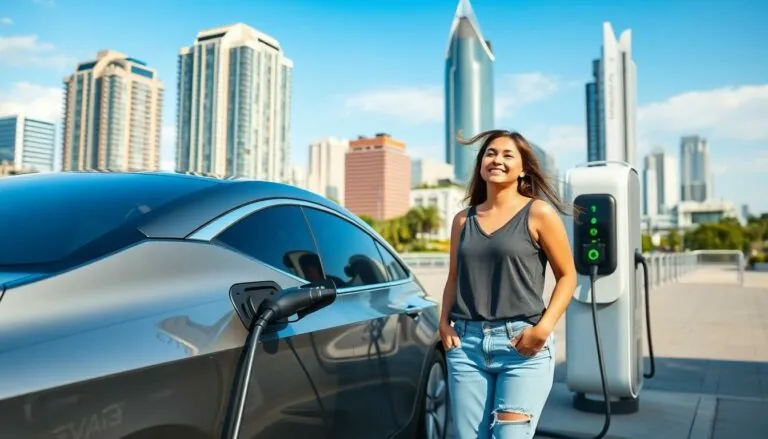Table of Contents
ToggleIn a world where convenience reigns supreme, electric convenience vehicles are taking the spotlight. Imagine zipping around town in a vehicle that’s not just eco-friendly but also a joy to drive. These nifty little rides are designed for those who crave efficiency and a dash of fun, all while keeping Mother Earth happy.
Overview of Electric Convenience Vehicles
Electric convenience vehicles represent a significant shift in the automotive industry. These vehicles focus on delivering efficient transportation options while minimizing environmental impact. Eco-friendly technologies integrate seamlessly into vehicle design, enhancing user experiences and promoting sustainability.
Utilizing electric powertrains, these vehicles accelerate quickly and offer lower operational costs than traditional gas-powered models. Battery technology continues to advance, extending range and reducing charging times for electric convenience vehicles. Consumers benefit from the convenience of charging at home or using public charging stations located throughout urban areas.
Features such as regenerative braking and smart technology enhance efficiency and safety. Regenerative braking systems recover energy during deceleration, improving the overall energy management of the vehicle. Many models also include advanced infotainment systems that allow for easy navigation and connectivity.
Market demand for electric convenience vehicles has grown steadily. In 2023, sales of these vehicles reached approximately 5 million units globally, indicating a strong consumer transition towards electric options. Major automotive manufacturers are investing heavily in electric models, broadening choices available for consumers.
In addition to environmental benefits, electric convenience vehicles provide an enjoyable driving experience. Quiet operation and smooth acceleration create a more pleasant ride. Drivers appreciate reduced noise pollution along with the absence of harmful emissions.
Electric convenience vehicles appeal to a broad audience, from urban commuters to families seeking more sustainable options. The combination of technology, efficiency, and eco-friendliness solidifies the role of these vehicles in shaping the future of transportation.
Benefits of Electric Convenience Vehicles

Electric convenience vehicles stand out due to their numerous advantages, particularly in environmental sustainability and cost efficiency.
Environmental Impact
Electric convenience vehicles play a crucial role in reducing greenhouse gas emissions. According to the International Energy Agency, electric vehicles emit up to 60% less carbon dioxide than traditional gasoline models. Improved air quality results from decreased reliance on fossil fuels. Sustainable practices also see an increase as more consumers adopt these eco-friendly options. Battery recycling initiatives further enhance the positive environmental contributions, highlighting responsible resource use. Governments worldwide frequently support electric vehicle adoption with incentives, emphasizing the commitment to sustainable transportation.
Cost Savings
Cost savings represent a significant advantage of electric convenience vehicles. Lower operational costs stem from reduced fuel and maintenance expenses, making them financially appealing. In fact, drivers can save up to $1,000 annually on fuel alone when switching from gas-powered cars to electric models. Electricity for charging usually costs less than gasoline. Rebate programs and tax credits also contribute to initial vehicle affordability. Furthermore, electric vehicles typically enjoy lower insurance premiums due to fewer accidents reported. Drivers recognize that the long-term savings make electric convenience vehicles an economically sound choice.
Types of Electric Convenience Vehicles
Electric convenience vehicles encompass a variety of eco-friendly options designed to enhance urban mobility. These vehicles cater to different needs, balancing efficiency and sustainability.
Electric Bicycles
Electric bicycles serve as popular alternatives for commuters and recreational riders. With a built-in electric motor, they assist pedaling, allowing users to cover greater distances without excessive exertion. Many models feature rechargeable batteries that provide ranges up to 70 miles on a single charge, making long rides more feasible. Additionally, electric bicycles promote healthier lifestyles by encouraging physical activity while reducing environmental impact. Urban areas benefit from their compact design, and they often require less parking space compared to traditional cars.
Electric Scooters
Electric scooters offer a convenient option for short-distance travel. Lightweight and portable, they can easily navigate through crowded city streets. Many designs allow riders to fold them for easy carrying and storage. With top speeds nearing 15 mph and ranges typically between 15 and 30 miles per charge, electric scooters are highly adaptable for daily use. Regenerative braking systems enhance their efficiency, enabling users to save battery life. Popular among students and young professionals, these scooters contribute to reduced traffic congestion and lower emissions, aligning with the growing movement toward sustainable transportation solutions.
Popular Brands and Models
Several brands lead the electric convenience vehicle market, each offering unique models tailored to various consumer needs.
Brand A
Tesla stands out as a pioneer in electric vehicles, setting the standard for performance and technology. The Model 3, for instance, captures consumer attention with a range of up to 353 miles on a single charge. Features like Autopilot provide advanced safety and convenience, making it ideal for urban commutes. With over 1 million units sold in 2023, Tesla models demonstrate exceptional popularity and technological advancement. Owners appreciate the seamless integration of software updates, enhancing vehicle functionality over time. Tesla’s Supercharger network ensures that long trips remain hassle-free, allowing quicker charging compared to competitors.
Brand B
Nissan offers the Leaf, which represents a practical choice for eco-conscious drivers. This hatchback provides a range of approximately 226 miles per charge, catering well to daily commuters. Nissan prioritizes safety with standard features such as automatic emergency braking and blind-spot monitoring. The Leaf has gained traction with over 500,000 units sold globally, illustrating widespread acceptance and reliability. In addition, its affordability makes it attractive for first-time electric vehicle buyers. The Leaf’s spacious interior and innovative technology enhance the overall driving experience, appealing to families and individuals alike.
User Experience and Feedback
User experiences with electric convenience vehicles often highlight their efficiency and comfort. Many drivers appreciate the smooth acceleration provided by electric powertrains, contributing to an enjoyable ride. Feedback frequently emphasizes the low operational costs associated with these eco-friendly models, which can lead to annual savings of approximately $1,000 on fuel.
Satisfaction with charging options plays a crucial role in user experiences. Consumers find home charging convenient, while access to public charging stations enhances usability in urban areas. With ongoing advancements in battery technology, charging times are decreasing, further encouraging adoption.
Safety features also receive positive remarks. Many users value the integration of smart technology, which assists with driving and enhances overall safety. Regenerative braking, a common feature, allows for energy recovery during stops, reinforcing efficiency.
In addition, reviews from families and urban commuters illustrate diverse preferences. Electric bicycles and scooters provide an appealing solution for those seeking sustainable alternatives for short distances. With ranges of up to 70 miles for electric bicycles and 30 miles for scooters, these vehicles cater to various commuting needs.
Notably, popular models like Tesla’s Model 3 and Nissan’s Leaf draw significant admiration. Owners of the Model 3 frequently mention its advanced features like Autopilot and extensive Supercharger network, reinforcing its status as a favorite among urban commuters. Meanwhile, the Leaf’s reliability and standard safety features make it a practical choice for families and first-time electric vehicle buyers.
Overall, electric convenience vehicles continue to garner positive feedback, showcasing their role in transforming the automotive landscape toward sustainability.
Electric convenience vehicles are reshaping the future of transportation. Their blend of efficiency and eco-friendliness makes them a compelling choice for a growing number of consumers. With advancements in technology and increasing market demand, these vehicles are not just a trend but a sustainable solution for urban mobility.
As more people recognize the benefits of reduced emissions and lower operational costs, the shift towards electric convenience vehicles will likely accelerate. The automotive industry is evolving to meet this demand, ensuring that these vehicles remain at the forefront of innovation. Embracing electric convenience vehicles is not just a personal choice; it’s a step towards a greener future for all.




